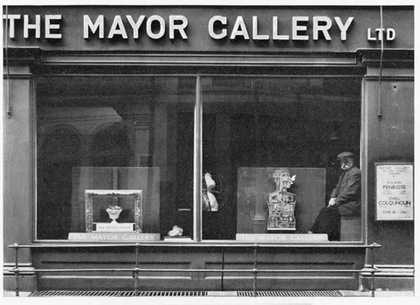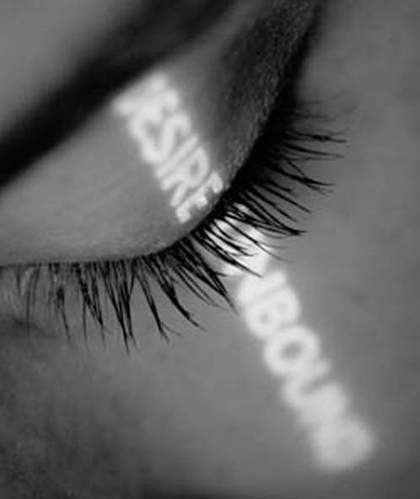On Saturday 4 July 1936, the International Surrealist Exhibition in London came to an end. In that same month, the Architectural Review magazine announced a competition. In April, they had published Paul Nash’ s article ‘Swanage or Seaside Surrealism’.1 Now, in July, the magazine offered a prize for readers who sent in their own surrealist holiday photographs – ‘spontaneous examples of surrealism discerned in English holiday resorts’ . The judges would be Nash and Roland Penrose.2
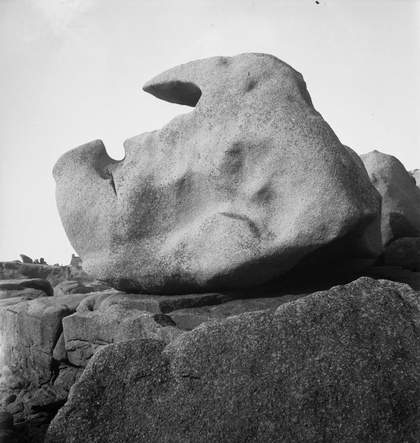
Fig.1
Eileen Agar
Rockface, Ploumanach 1936
View the main page for this artwork
At face value, this could be taken as a demonstration of the irredeemable frivolity of surrealism in England (it is difficult to imagine a surrealist snapshot competition in Paris judged by André Breton and Max Ernst). But in a more positive light, it exemplifies rather well the interest that the English had in popular culture and in pleasure. Holidays were very important in English surrealism and some of its most interesting work was made during them. This essay will examine closely one particular set of photographs made by Eileen Agar in that month of July 1936 which illustrate this relationship between surrealism in England and pleasure.
Eileen Agar had been one of the English stars of the surrealism exhibition, even though she had apparently not thought of herself as a ‘surrealist’ until the organisers of the show – Roland Penrose and Herbert Read – came to her studio and declared her to be one. But in her case, there was a good deal of justification for the label. Agar was of course primarily a painter and object-maker.3 This essay, however, will leave her other achievements in the background to examine the photographs she made after the end of the surrealist exhibition, when she and her partner Joseph Bard went to Brittany on holiday and ‘landed up at Ploumanach, a small village on the north coast, famous for its extraordinary rock formations.4
In her autobiography, published in 1988, Agar wrote: ‘We chose this stopping place by looking out of the train and trusting to chance, like all good surrealists’.5 This is a splendid image, suggesting a spontaneous discovery of the site. But, even in the 1930s, the rocks of Ploumanac’h – to use the Breton and Anglicised spelling of the place name – were well known, and the ‘côte de granit rose’ of which they formed part was popular with holidaymakers, as well as being of cultural significance. (In 1901 it had been the first coastal site in France to be protected by law.)6 Ploumanac’h featured in British guides to Brittany alongside Perros-Guirec, a larger and more popular resort two kilometres to the east. In one, a large fold-out advert announced: ‘Intending visitors to Brittany should note that the hotels and pensions of Perros-Guirec cater especially for British visitors throughout the season’.7
But perhaps Agar and Bard had deliberately travelled without a guidebook. The second problem, though, is more particular. Agar makes it sound as if they just leaned out the train window and ‘Before us were the most fantastic rocks’.8 Unfortunately, it could not have happened quite that way since the railway line did not actually go to Ploumanac’h, but stopped at Perros-Guirec (a far less rocky sight. In short, it would have been difficult to go to Ploumanac’h without intending to do so, and without knowing that one would find a magnificent rocky coastline when one got there.
Anyway, there they were and Agar was stunned by the extraordinary landscape. As she wrote fifty years later, ‘a camera became a necessity’, so a day or two after their arrival, Agar and Bard went to Brest where she bought the Rolleiflex 6 x 6 camera that was to be ‘my constant companion for many years’.9 It is the photographs that Eileen Agar took at Ploumanac’h that now provide one of the most coherent group of images to exemplify the fascination of the surrealists for the fantastic in nature. Owing to their essentially ‘documentary’, even ‘amateur’ status, however, they have been consistently undervalued – not least by Agar herself.
At her death in 1991 Eileen Agar donated her photographs to the Tate Gallery Archives, some in the form of prints, many only as negatives. There are in all about seventy images made at Ploumanac’h – six films’ worth – and their aesthetic and technical success is variable. As well as the rocks, Agar and Bard photographed each other: there is one image of him sitting (in suit and tie) on the rocky beach in front of their hotel (fig.2).10 In Perros-Guirec, Agar photographed the asymmetrical church of St. Jacques, the butcher’s shop of L. BOUBENEC next to it, as well as the Boubenec family tomb in the graveyard. She also visited and photographed the mock-gothic castle on the Ile de Costarès in the bay opposite Ploumanac’h, where Henryk Sienkiewicz had completed his mammoth biblical novel Quo Vadis in 1896.11
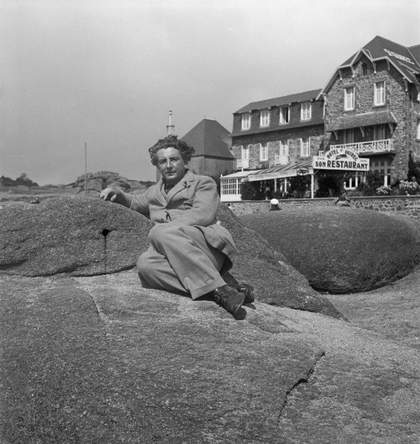
Fig.2
Eileen Agar
Joseph and the Hotel de Guirec, Ploumanach 1936
View the main page for this artwork
However, the vast majority of Agar’s photographs concentrate on the rocks themselves and, even working with a new camera and sometimes getting her exposures wrong, her visual instincts enabled her to make a clutch of remarkable images.12 But one might ask why Agar felt the need for a camera. Why did she not do what any other painter would do and start sketching the rocks? The probable answer is twofold. First, she was overwhelmed by the physical actuality of the rocks and initially impelled to record them rather than transmute them into art – that might come later. Secondly, she knew of other artists who had used a camera alongside the pencil and paintbrush, which made the idea of shifting between mediums both more possible and more attractive, the most immediate example would, of course, have been Paul Nash, with whom Agar had worked and begun an affair in Swanage in 1935.
The second question, though, is – why that camera? After all, Nash had never moved beyond a little Kodak. The Rolleiflex square format camera was generally the choice of professional photographers: Bill Brandt used one, as did Brassaï.13 One can only guess that Agar instinctively realised that the Rolleiflex has a number of qualities which would help her achieve her aim. The larger negative gives a sharpness and density, the square format gives a formality and centrality, while the fact that one makes the pictures looking down at a screen rather than through a viewfinder distances the photographer from the scene itself.
If the direct experience of Ploumanac’h was the major impulse for these pictures, there was also an artistic context to which they can be related. Looking for parallels to Agar’s photographs, one most obviously turns back to the interest in natural forms so central to English surrealism and nowhere more so than in the paintings, objects and photographs of Paul Nash. There are important differences. Nash’s art has little of the humour and love of excess one finds in Agar’s work. But certainly Agar’s sense of the objet trouvé in nature had been greatly developed by her relationship with Nash. The most dramatic example was perhaps the ‘Seashore Monster’ – a rusted old anchor – that Agar had found on the beach and which both she and Nash photographed and which he included in his collage Swanage.14 I will return to this object and its relationship to the Ploumanac’h photographs later.
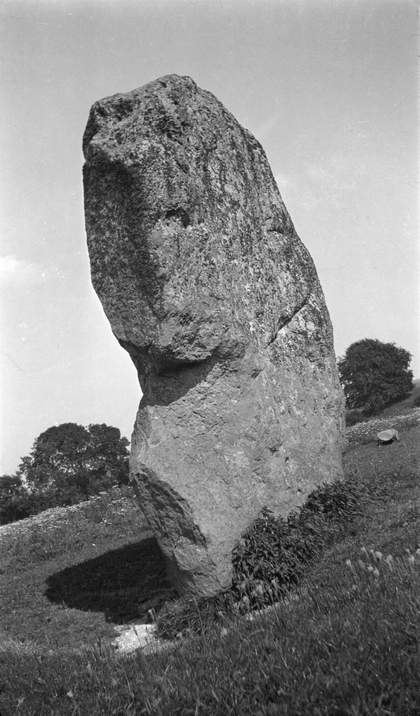
Fig.3
Paul Nash
Avebury Sentinel 1933
View the main page for this artwork
If Nash’s influence was formative in Agar’s decision not to sketch or paint these rocks but to photograph them, one might also recall Nash’s habit of collecting stones, such as the Nest of Wild Stones which he found that same year.15 But those rocks were tiny, hand-sized; part of the effect of Ploumanac’h lay in its scale.16 In terms of size and animistic presence, the closest parallel we might find is in the standing stones of Avebury which Nash had photographed in 1933 (fig.3) (Agar herself went there later in 1939).17 Agar described one rock at Ploumanac’h as ‘a foot rearing up like a dolmen’,18 and there are several rocks which are reminiscent of standing stones. There is a particular resonance to her making the connection between natural forms and man-made prehistoric forms in Brittany, where dolmens and megaliths abound and do indeed become part of the natural landscape. However, as we shall see, it was crucial for Agar that these forms were not man-made but natural, ‘sculpted by the sea, that master-worker of all time’.19
Looking elsewhere in English surrealism, the examples of Henry Moore and Graham Sutherland serve to remind us of just how diverse the ‘Surrealism of Nature’ was in the late 1930s. It is not only that the natural forms evoked by Moore and Sutherland are so different – rounded on the one hand, spiky on the other – it is also that the meanings the two artists read into nature were opposite: harmony and wholeness versus struggle and antagonism. Agar found herself between these two poles.
Throughout the late 1930s, Henry Moore continued to identify himself as a surrealist and, as late as June 1940, his large Reclining Figure held centre stage in the Surrealism Today exhibition at the Zwemmer Galleries.20 Yet, even in his work that still had a surrealist edge, one can now see the extent to which it was already informed by what the writer Geoffrey Grigson in 1948 was to refer to as the quality of a ‘wide sea embracing unity and humanity’.21 Moore’s work had a direct influence on the photographer John Havinden who in 1935 made some Dufaycolour images of seaside rock forms, emphasizing this harmony of natural forms.22 But while Moore’s example would have encouraged the sculptural and the monumental, his forms lacked the strangeness and excess of the rocks at Ploumanac’h – and indeed the humour.23
In comparison, Graham Sutherland’s metamorphoses were animistic, disquieting and indeed threatening, albeit largely vegetable. Sutherland was at most on the fringes of surrealism in the late 1930s; he had two untypical works in the 1936 exhibition and thereafter severed formal ties altogether, but he was later to acknowledge the role that surrealism played in forming his aesthetic: ‘Surrealism helped me to realise that forms which interested me existed already in nature, and were waiting for me to find them’.24 It was the same revelation that struck Agar and Nash.
Perhaps the closest equivalent in Britain to the Ploumanac’h landscape is Brimham Rocks in Yorkshire, which Sutherland had visited in 1935 and may well have told Nash and Agar about. In 1937 Sutherland would produce a highly coloured image of Brimham for a Shell poster and, the same year, he published his essay about it – ‘An English Stone Landmark’ – in the anthology A Painter’s Object.25 This short text has much in common with Agar’s response to Ploumanac’h, especially at the point when Sutherland compares a particularly dramatic stone to ‘a growth which one sometimes sees attached to the nose of a peasant’.26
But it is not only to English art that we should look in searching for parallels and possible influences for Agar’s Ploumanac’h photographs. For Agar was quite different from Moore, Sutherland and especially Nash, in that she showed no concern at all for the ‘Englishness’ of her response to nature. Her work is far less attached, if at all, to any particular sense of place and it is not insignificant that she found her rocks in Brittany rather than Dorset or Yorkshire. Of the English surrealists, only Penrose would be closer to the French group.
In the summer of 1936 Agar’s mind must have been full of images from the International Exhibition. Her own later account of the discovery of Ploumanac’h emphasised the sense in which it was an extension of the surrealist summer of 1936: ‘Our surprise and delight at the discovery came as a bonus after the excitement of the exhibition in London. It was as if nature had arranged a show of sculpture in the open air, just to prove that she too was keeping her hand in’.27 (It is characteristic of Agar here to elide the workings of nature and art.)
One tends to think of Parisian surrealism as essentially urban – as indeed it was – but looking at photographs of the London exhibition, one is struck by how much natural imagery there actually is – in paintings by Joan Miró, Max Ernst, Yves Tanguy and Salvador Dalí, sculptures by Arp and Brancusi as well as Moore. It is therefore as valid to suggest continental parallels as much as British ones for the Ploumanac’h images and Edouard Jaguer has proposed three. One is in a particular photograph where an individual rock resembles the Easter Island heads as depicted by Ernst in Une semaine de bonté. But more generally, he also cites resemblances to the rock-like forms in the paintings of Tanguy and Dalí.28
As indicated earlier, it was significant that Agar made her photographs in Brittany, where both natural rock formations and prehistoric monuments are integral to the landscape. The paintings of Tanguy have their roots in that same landscape. Tanguy had spent his childhood summers in Brittany and it is hard not to connect the forms that multiply across his paintings with the objects that people that country.29 More generally, Brittany was a significant presence in French surrealism, particularly – given his surname – for the leader of the surrealist movement André Breton himself. Breton made regular visits to the peninsula, and, at the same time that Agar and Bard were in the north, he and his wife Jacqueline were on the south coast, where on July 20, they walked along a beach near Lorient and had the disquieting experience that Breton later recalled in his great novel L’Amour fou.30
But probably the most direct connection with Agar’s images can be made with the way that Salvador Dalí derived many of the forms in his paintings of the early 1930s from the Catalan coastline near his birthplace Cadaqués.31 His description of the ‘grandiose geological delirium’ of these rocks is similar to Agar’s comments about Ploumanac’h.32 However, Dalí hardly used the rocks themselves directly in his work (except, of course, for their appearance at the start of the film L’Age d’or). Turner Historian Oriana Baddeley has argued that while Dalí transmuted the forms of the rocks through memory and desire, Agar’s work ‘reveals not her personal fantasies but her recognition of the magical and comic power of nature itself’,33 although, as we will see, the distinction between fantasy and reality is not quite that clear cut in Agar’s work either).
There is, finally, one other continental parallel, this time a photographic one. Mary Ann Caws in her recent book on surrealism reproduced one of Agar’s photographs while noting a precedent in photographs made by Raoul Ubac in 1933 of rocks in Dalmatia.34 Of his experience on the island of Hvar off the Dalmatian coast, Ubac later said that, ‘It was there that was born my love of stone’,35 an attraction which would manifest itself indirectly in the better known solarisations and ‘bas-relief’ fossil photographs that he made for Minotaure in the late 1930s. However, it seems that none of the Dalmatian photographs were reproduced until 1938, when one of them appeared in the Dictionnaire abregé du surrealisme, along with two strange ‘objets naturels’, an inclusion which underlines the interest of the Parisian surrealists in natural forms.36
There were, then, a plethora of possible sources and parallels for Agar’s Ploumanac’h photographs, but how any of them related to her images, one cannot say. When asked about this in 1985, she cannily replied that she was not aware of influences from these other artists, but that did not mean they were not there.37 Nevertheless, the primary revelation of Ploumanac’h was the discovery of natural forms that paralleled the forms created by these artists. It was Agar’s version of the revelation – succinctly described by Sutherland – that the surreal pre-exists any attempt by the artist to make images of it. But the second phase, the documentation of that experience through photographs, was equally important. It was a necessary concretisation of the experience, and the photographs were to stay with her for many years as a sort of ‘proof’ of that reality.
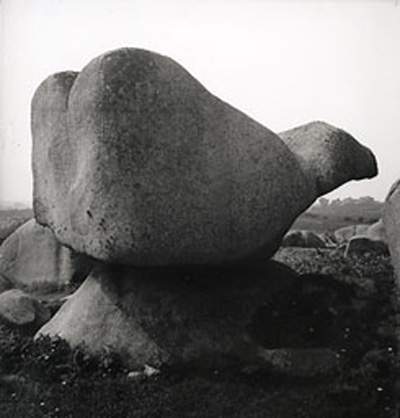
Fig.4
Eileen Agar
Bum and Thumb Rock, Ploumanach 1936
View the main page for this artwork
In her account of the rocks, as in the photographs she took of them, Agar stressed their animistic qualities: ‘They lay like enormous prehistoric monsters sleeping on the turf above the sea’.38 Both her description of the rocks and the titles she later gave some of them – ‘Rockface’, ‘Bum and Thumb Rock’ – transposed them into so many bodily parts (figs.1,4). Nevertheless, it was crucial for Agar that these forms were created by the forces of water, wind and chance. The ‘surrealism’ of natural form was an even more central concept for Agar than it was for Nash. Much later, she was to say: ‘I am very much a nature-worshipper and I always try to bring nature into my work … On the whole I feel that nature is something free. Nature can produce the most astonishing shapes that you could never dream of’. She continued by referring to the ‘wild frenzy that Nature can show’.39
In this, perhaps, lay the very particular appeal of the Ploumanac’h rocks for Agar. They are the frozen relics of this natural frenzy, held in a perpetual tension. A tension that is increased by the gap between our knowledge that the rocks are freak, meaningless objects created by accident and the fact that the human mind can so easily make such a close anthropomorphic reading of them. As Nash also knew, nature is both something determinedly other and something that we are part of and are drawn to conceptualise.
But was this relationship different for Agar as a woman than it was for Nash as a man? The art historian Whitney Chadwick reproduced one of the Ploumanac’h photographs alongside paintings by Toyen and Frida Kahlo and a photograph by Lee Miller under the rubric ‘The Female Earth’ in her book Women Artists and the Surrealist Movement.40 Unlike some other female surrealists, Agar did consider her gender important for her work, arguing that women, through what she called their ‘womb-magic’ , had a more direct line to a natural and unconscious creativity.41 Agar always claimed, however, that her art was incompatible with motherhood: one might perhaps see Lee Miller’s photograph of Agar ‘pregnant with her camera’ (the phrase was apparently Picasso’ s) not only as a good joke but also as a keen insight into the nature of Agar’s creativity.42
However, Agar herself never suggested that she thought of the Ploumanac’h photographs as particularly feminine images, and perhaps she did not consider the mechanical medium of photography in those same creative terms. But one element in the Ploumanac’h images lay in their parallel fusion of a natural (feminine) subject with a mechanical (male) medium. One could also find a clue from Agar’s discussion of the ‘Seashore Monster’ she and Nash had worked with, which she considered as a sort of hermaphrodite object – male and female fused. She also described the object – as she did the rocks – as created by a fusion of land and sea which ‘often play together like man and wife, and achieve astonishing results’.43
In fact, the relationship between Nash and Agar had reached a crisis point immediately before she and Bard went on holiday. On 15 July, presumably just before they left, Nash wrote her an impassioned and agonised letter: ‘Eileen forgive my last desperate attempt to see you again. It was foolish & selfish but I had faced the idea of parting and we had said goodbye and then the knowledge of your being here still for several days was too difficult to ignore – that damned gnawing began again – I could not resist.’ He went on to say that they should end their affair, for the sake of their partners as well as themselves. But the letter concludes by ecstatically celebrating the relationship: ‘If we break now it is not because we are tired, we break at the peak of our flight where we have climbed dizzily like birds who make love in mid-air heedless of where they soar. We have not yet fallen down our bright sky, we only could not face the threat of the storm – O my bird my dear love’.44
It is impossible to know what effect this created for Agar once she was in Brittany. But one might wonder whether her choice of rocks to photograph was not affected by Nash’s rhetoric, whether she chose a subject so deliberately solid and earthbound in contrast to his evocation of weightless flight. And to go further, whether the rocks did not represent in some way her relationship with the reliable yet quixotic Bard – a man of considerable bulk – whose sexual vigour she constantly extolled in contrast to the asthmatic and ailing Nash.
In considering the sexual connotations of the Ploumanac’h pictures, it is interesting to put them next to the slightly later painting Scylla by another female English surrealist Ithell Colquhoun (fig.5). Painted in 1938, it was, according to the artist, based upon ‘what I could see of myself in a bath – this, with a change of scale due to “alienation of sensation” became rocks and seaweed’.45 But at the same time, the two knees are transformed into phallic rocks which converge to form a vagina-like slit through which a small but sharp pointed boat is about to slip. As the art historian Dawn Ades has noted, this painting poses ‘a challenge, so explicit as to verge on parody, of a specific form of sexual imagery exploited by the surrealists, that which treats landscape metaphorically as a woman … (it is) an almost mocking response to the prevailing imagery of eroticism with surrealism’.46 What is male and what is female thus becomes thoroughly confused, undermined by a sharp and darkly surrealist wit.
Agar’s photos are also often rather funny, although their humour is less challenging than that of Scylla. They are full of what the artist Tacita Dean has called ‘levity, mirth and re-imagination’,47 another quality that separates Agar from the other English nature-artists and might signal her female undermining of their male pomposity. As the ‘bum’ ends in a ‘thumbv, as rocks seem to whisper to each other, as a smaller rock balances on a larger like some fashionable hat (fig.6),48 one senses that Agar delights in the ridiculousness of her images, a ridiculousness created in the space between the sense of the rocks as simply rocks and her deliberate reading of them as heads and faces, bodies and monsters. Agar deliberately takes the ‘pathetic fallacy’ that can be so dangerously sentimental and plays with it to make images that are indeed sublime and at the same time carnivalesque – a ‘comic sublime’.
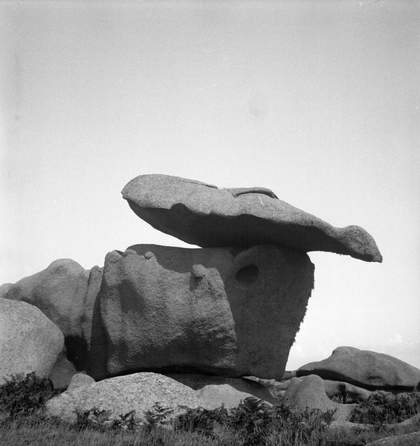
Fig.6
Eileen Agar
Rocks, Ploumanach 1936
View the main page for this artwork
But that quality of humour is in turn held in place by Agar’s rigorous picture-making. Although she was a novice photographically, she was not so pictorially. The square format gives balance and stability to the pictures, while the large negatives have an intensity of detail altogether unavailable to Nash with his little Kodak. The rocks are also usually photographed so that they fill the frame and dominate the space with no apparent context. The intensely black shadows thrown by the summer sun dramatise and animate the rocks, while their consistent placement against a flat, empty sky emphasises the crisp delineation of their outlines. So while the rocks may often be comic, they are also dramatic characters, standing alone and eloquent.
It is difficult now to reconstitute Agar’s process of photographing, since she later cut the original negative strips into single images. (Moreover, the film does not have edge markings to help put shots in sequence.) However, on a couple of occasions, she photographed the same rock from different points of view and, since the negatives are cut rather roughly with a pair of scissors, one can fit them together to confirm that she only made one negative from each angle. Indeed, it seems that for most of the best shots, Agar took just one image and got the picture. We might take this either as a indication of her certainty or of her naïvety (or, indeed, that she had only bought a limited amount of film). But she rarely shot from a number of angles as a more experienced photographer might have done.
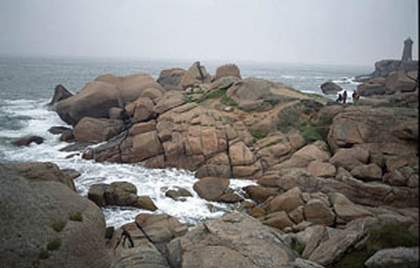
Fig.7
Ian Walker
Rocks, Ploumanac’h 2004
Colour photograph
© Ian Walker
A visit to Ploumanac’h helps to demonstrate just how particular Agar was in making her pictures.49 Arriving there, two things hit one straightaway, primarily because they are both absent from Agar’s photographs. One is the sheer scale of the site, the excessive piling up of rock on rock, which makes one realise that Agar had been very disciplined in restricting herself to the ‘portraiture’ of individual rocks (fig.7). The other element is the colour of the rock, which can shift through the day from a pale beige to a rich, deep red at sunset.50 Eileen Agar was an enthusiastic colourist in her paintings and would surely have been so in her photographs had it been technically possible. But perhaps she was lucky that at the time she made the photographs, colour was not yet the norm for the aspiring amateur. Certainly she would have lost much of the dramatic physicality that black and white gave her.51
Finding the individual rocks that Agar photographed also demonstrated something of her tactics. Both of the rocks in figs. 8 and 9 are by the path across the headland and in both cases Agar has photographed them from low down to remove the background and emphasise their scale. Agar was quite short and she had the camera at waist level, but here she must have crouched or knelt down even further. This suggests a process of observation before she actually made the picture (a process which may also have affected her decision to make just one shot of each rock). In the final pictures the scale of two rocks is quite deceptive. The rock in fig.8 is perhaps fifteen feet high, the one in fig.9 five or six feet. In the photographs they both seem equally grand.
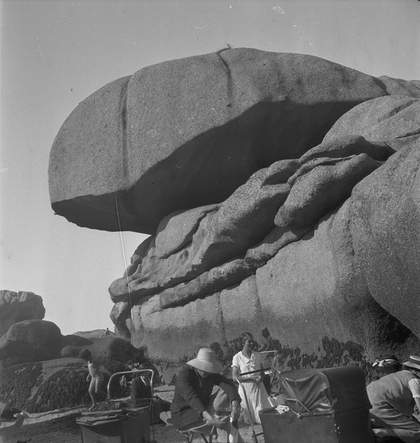
Fig.8
Eileen Agar
Rocks, Ploumanach 1936
View the main page for this artwork
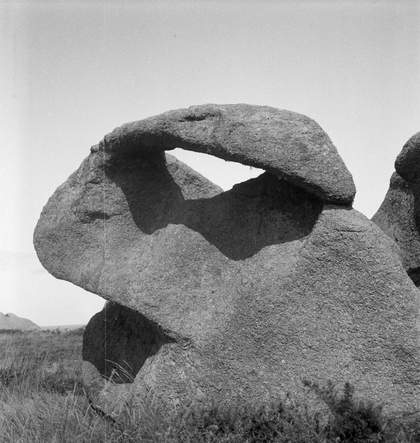
Fig.9
Eileen Agar
Le Lapin, Ploumanach 1936
View the main page for this artwork
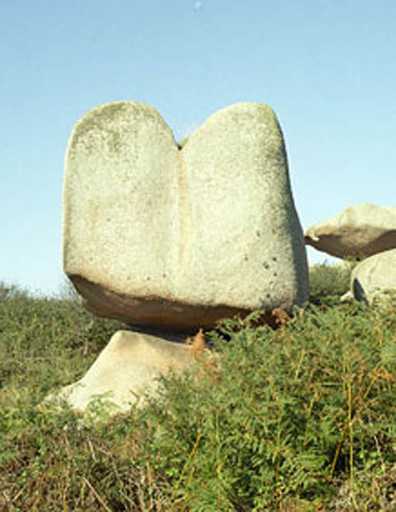
Fig.10
Ian Walker
Les Tables de la Loi, Ploumanac’h 2004
Colour photograph
© Ian Walker
The other striking feature of Ploumanac’h is the fact that nearly all the major rocks have acquired names – ‘le diable’, ‘la champignon’, ‘la tête de mort’, ‘la palette du peintre’, ‘le pied’ and so on. On one level, this provides an enjoyably folkloric element to the experience of them. On another, however, it restricts the play of meaning, assigning just one identity to each rock. Agar was wise on the whole to avoid such overt (if tempting) naming of the rocks. Most of her images were factually titled: ‘Rocks, Ploumanach, 1936’. In only one case – ‘Le Lapin’ – did Agar use the name already given to the rock and that she did as part of her own play with the rock’s metamorphosis (fig.9). With a couple of other images, she gave the rocks names that emphasise the metamorphic qualities that she had found in them and which are at odds with their common naming. The ‘Bum and Thumb Rock’ is actually known as ‘The Tablets of the Law’ because, when seen from end on, the ‘bum’ flattens out to resemble the double shape of the Ten Commandments (fig.10). (One can imagine Agar’s quiet delight that she had managed to turn the tablets of the law into a bum.)
But this also emphasises the sense in which these namings – like photography – depend upon a two-dimensional reading of the rock’s three-dimensional physicality. In many cases, the name given to a particular rock only makes sense from one particular angle. From the other side, it is something quite other. The rock known as ‘La Bouteille’ turned into something both more humorous and more sinister when Agar went round the other side and found a smudged face in the erosion of its base (fig.6, fig.11). There are indeed several examples in the Tate Archives where one might suspect that two images show the same rock from different angles but this could only be verified on site. One of Agar’s rocks I was unable to find at Ploumanac’h – the one she titled ‘Rockface’ (fig.1). It could have been any one of hundreds of rocks, seen from just the right angle as one glanced toward it in just the right frame of mind. Photography, even of such solid things as rocks, often depends upon momentary conjunctions which quickly disappear if they are not grabbed straight away. Indeed, had she gone back the following day, Agar herself might not have been able to find ‘Rockface’ again.52
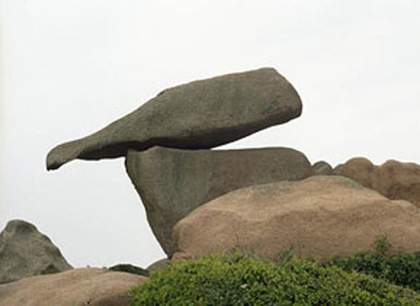
Fig.11
Ian Walker
La Bouteille, Ploumanac’h 2004
Colour photograph
© Ian Walker
A few of the Ploumanac’h photographs show objects or activities other than the rocks themselves. In one, the crinkled rockface is topped by a lighthouse, which in its white geometry is reminiscent of modernist buildings of the 1930s.53 Whether consciously or not, Agar in this image contrasts the natural and the man-made, the organic and the geometric. Although the building is on top of the rocks, its stability and apparent dominance does not seem very assured. A parallel reading can be made of several pictures where Agar’s fellow holidaymakers are included in the image (in one case pushing a pram) and, in the words of Edouard Jaguer, act as ‘a humorous and absurd counterpoint to the majestic mineral mass’ (fig.12).54 The placement of these figures at the bottom of the frame, small beneath the rocks yet apparently unheeding of their power, again suggests the fragility of human activity in this context.
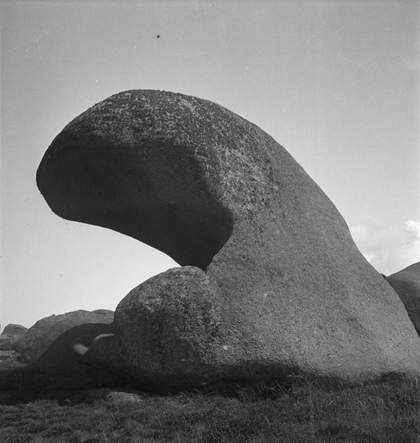
Fig.12
Eileen Agar
Rocks, Ploumanach 1936
View the main page for this archive work
However, there is a more problematic way in which to read these images with the holidaymakers. Perhaps Agar, in her primary desire to record the rocks themselves, was actually uninterested in what else was in the picture and able to ignore the presence of the people. The implication of this reading is that Agar was also uninterested in the photographs themselves as images. Agar’s photographs thus operate as a sort of indexical sketchbook, a process which would lead to something else of more substance and value. Certainly, she herself was later to deny her photographs any serious place within her art (as opposed to the informational, inspirational role they certainly did play).55 But the best of the photographs are too well made, too compositionally exact and too precisely framed, to be thought of as mere casual experimentation. It would seem that, in making these pictures, Agar was able to be both playful and serious, casual and rigorous, so that we can never be quite certain as to their status, either at the point they were taken (since Agar’s conscious intentions may have been rather different from her unconscious desires) or later on, as they acquired a greater value, both for the artist herself and for a broader audience. But it is also this instability that makes the pictures so challenging.
We are left with another paradox: that these pictures can be so unsettled in their status and at the same time can in retrospect be seen as one of the most coherent and consistent statements of an aesthetic of a natural surrealism. What this suggests is the ambiguous and undervalued place that photography had within artistic practice, particularly in relation to landscape and particularly in England, where painting has long had a dominant cultural linkage with landscape. Photography vitally extended that tradition, but it seems that the extent of its contribution could not be fully acknowledged. Perhaps it was that photography also undermined the tradition, laying (for its practitioners) too much emphasis on the actual and too little on the imaginative.
The relationship between the actual and the imaginative was a fundamental issue for surrealism itself. Here is Herbert Read writing in 1936 of the surrealist objet trouvé as found in nature by Nash and Agar: ‘If I am walking along the beach and my eye catches a sea-worn and sun-bleached knot of wood whose shape and colour strongly appeal to me, the act of identification (which may in any case have a psychological explanation) makes that object as expressive of my personality as if I had actually carved the wood into that shape’.56 Initially, Read poses the experience as ‘eye-catching’, immediate, visceral, indeed, as an instantané, a sort of mental snapshot. In this, he is sounding the same note as Paul Nash when he wrote of the surrealist found object that ‘by finding, you create it’.57
Stated so simply, this is a radical concept (and one can see why Nash would have been so intrigued by photography, simultaneously both a finding and a creating). But immediately Nash, like Read, places the experience back within the terms of a personal creativity, adding that this found object ‘has always been yours, living, as I understand, in the unconscious until the accident of your perception gives it birth’. It is a position – accepting the otherness of the found at the same time as one recognises it as one’s own – to which Agar would surely have also subscribed, although it seems that in this respect she found the photographed object of less interest than the actual object found on the beach (whereas Nash seems to have found both intriguing in parallel but subtly different ways).58
Agar’s photographs from Ploumanac’h remained unexhibited and unpublished. But she did do a number of things with them. One was to stick some of them into an album. This might seem rather trivial, but the way the album is arranged suggests that she was not only commemorating her holiday, but also using this as a way to think about the images. Portraits of Joseph and Eileen are mixed with photographs of places and of Agar’s art works (including the ‘Seashore Monster’), with the stones featuring large on several pages. Here again the ‘professionalism’ of equipment and image-making practice stands in contrast to the ‘amateurishness’ of preservation and presentation, and Agar’s albums have many pages where the aesthetic, the anecdotal and the surreal overlap.59 (This form of photographic montage was as common within surrealism as it is in society more generally and, on the whole, it was just as private. But there are a few places where it became an intriguing part of the photographer’s practice. Perhaps the best examples are the sheets of card where the Czech surrealist Jindřich Štyrský laid out contact prints of his images to create intriguing and often indirect relationships, but this is more developed than Agar’s use of the album here.)60
Agar worked with the images of the rocks in other ways. She made at least one small painting called Rock Form, based on one of her photographs and emphasising the anthropomorphic features of the rock in a way that prefigures the paintings of Objects from a Landscape that she would make in the 1980s.61 More interestingly, she also experimented with cropping the photographs themselves, taking small squares out of them to produce radically new compositions.62 In a couple of cases, she cut down sepia-toned postcard images of the rocks that she had bought at Ploumanac’h, but she also submitted her own photographs to the process. In one work, she brought together the central parts of two pictures and montaged them one above the other, turning one of the photos on its side in the process. The actual cutting is done rather roughly which suggests a carefree spontaneity and experimentation. But while these images emphasise an amorphous abstraction through their close focus, they also discard the strongest element in the original photograph – its direct and precise framing of the whole rock – in favour of a more fragmented and, indeed, formalist vision.
The other thing that we can be fairly sure Agar did with these photographs was to show them to her friends, notably Paul Nash and, of course, Lee Miller. The images by Nash that most resembles the Ploumanac’h pictures are the Monster Field photographs he made three years later in 1939.63 These images are, of course, of trees not rocks (although, in 1936, Agar had also photographed a dead tree on the beach at Perros-Guirec), but their animism is closer to Agar’s photos than to Nash’s own previous work and they share a sense of the organic, the monstrous and – to an extent – the parodic merged together. Like Agar, Nash liked the idea of these ‘monsters’ as creatures stranded by the retreating sea, as forms which are both prehistoric and strangely modern.64 Also in 1939 at Siwa in Egypt Lee Miller made a single photograph of a rock, a particularly pointed example of her work from that period, which, as her son Anthony Penrose has described, is dominated by landscape subjects containing ‘some quirky juxtaposition or observation’ that expresses ‘the oblique poetry of the surrealist eye’.65 When it was reproduced in the London Bulletin, the photograph was given the title The Native, making it exotically humanoid.66 But Miller also apparently called the picture Cock Rock, a title containing a double metaphor. Most immediately, it is compared to the head of a cockerel, with the form at the top becoming a beak and a small shadowed hole an eye (a process not unlike Agar’s photographing of ‘Le Lapin’). But, of course, the title also more colloquially invokes an erect phallic form, making explicit the sexual connotations which may be found in Agar’s rocks.67
In the following years, Eileen Agar took many photographs with her Rolleiflex, although never again did she work with such concentration and intensity. Many of her later pictures were also made on holiday, including the well known images of Picasso, Dora Maar, Paul and Nusch Eluard, Roland Penrose and Lee Miller on the bench at Juan-les-Pins in the summer of 1937, which despite Agar’s superior equipment, are really well-made snapshots.68 There are also individual pictures which are again reminiscent of Nash in the range of their subject-matter, but tend to be more exotic, more decorative and patterned, using richness rather than spareness to create a quality of disquietude. This generalisation is also true of Agar’s paintings and objects such as the famous Angel of Anarchy (fig.13). It was an essential part of her aesthetic to use excess to create imagery that was at once decorative and surreal.
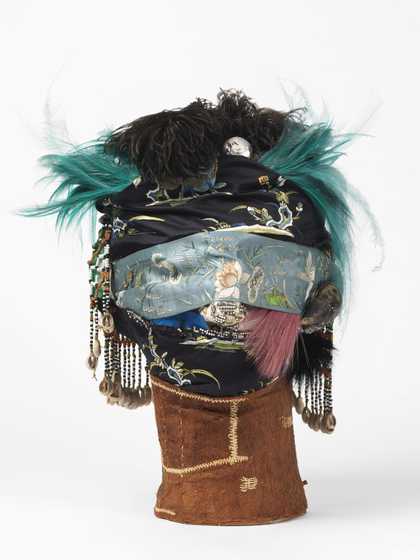
Eileen Agar
Angel of Anarchy (1936–40)
Tate
Particularly reminscent of Nash are Agar’s images of wooden and stone forms, sometimes natural, sometimes artifical. She photographed standing stones in Cornwall and Ireland, and also made images of the sort of folk craft objects collected by the surrealists – a ship’s figurehead or coffin lids in the form of sharks. More ambiguous were objects such as the Physical Education construction frame she had photographed at Perros-Guirec or a large concrete beach defence photographed the following year near Toulon. Most extraordinary was a large globe made of ribs of metal held together with studs, again found on a French beach (Agar’s affinity for the seashore is clearly revealed in her photographs). It is an impressive object whose purpose seems quite obscure, albeit reminiscent perhaps of the Swanage globe that Nash wrote about or Roland Penrose’s 1936 sculpture Captain Cooks Last Voyage (fig.14).
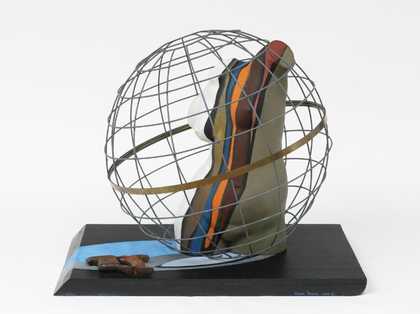
Sir Roland Penrose
The Last Voyage of Captain Cook (1936–67)
Tate
Agar did not exhibit any of her photographs until 1976, when the New Art Centre mounted a show of her work from the 1930s. In this she showed a group of twenty-one photographs, including a couple of the Ploumanac’h rocks.69 Roland Penrose wrote the catalogue introduction, remarking that: ‘The whole of nature began to open up treasures for her and speak to her in a new way. Stones became her children, the sky and the sea her intimate friends’.70 It was his interest that led to two of the photographs being included in the mammoth 1978 exhibition Dada and Surrealism Reviewed at the Hayward Gallery.71 However, they were not hung on the wall with other works of art by the British surrealists, but rather placed in a vitrine with a selection of chosen objects.72 It seems that it was the rocks themselves that were of interest, not the photographs. By implication, they acted only as a sort of stand-in for the actual rocks. However, the two images were intriguingly and evocatively titled Magnetic Memories I and II. Although suggestive of the continuing power of the rocks, the title was not used again.
Thereafter, the photographs were included in a number of exhibitions and books on surrealist photography. In the catalogue of what was probably the first exhibition of surrealist photography held in 1979 at the New Gallery of Contemporary Art, in Cleveland, Ohio, one of Agar’s Ploumanac’h pictures is placed opposite Nash’s photograph of a beached boat at Toulon.73 In his compendious study of surrealist photography, Les Mysteres de la chambre noire of 1982, Edouard Jaguer included three of Agar’s pictures.74 (It is interesting to note that both these early publications featured the images that Agar had made of holidaymakers with the rocks, suggesting that these were not regarded by Agar or anyone else as unintentional juxtapositions.) Later in the decade, five photographs by Agar (two from Ploumanac’h) were included in the exhibition Das Innere der Sicht, mounted in Vienna.75 However, the one exhibition of surrealist photography that did not include Agar’s pictures was the one that at the time was thought of as the most definitive: L’Amour fou, held in 1985.76
By the mid-1980s it would seem that Agar had established a small corpus of the Ploumanac’h photographs with which she was satisfied. Some of these had been published or exhibited – perhaps only half a dozen – while others she kept as prints.77 When I saw these in 1985, they included some of the better known pictures but also others that remained unpublished. There was, for example, one double exposed image, ghostly rocks hovering like clouds above the landscape. As with Paul Nash’s double-exposures, one might see this as either an accident or a piece of experimentation (later on, there would be examples where Agar obviously made the double-exposure deliberately – an image of herself and Bard superimposed over each other, for example). Whatever questions this might raise about Agar’s control and volition at the point of making the picture, the fact that it was preserved as a print demonstrated that she valued it whether or not it had been an accident.
It was this re-evaluation of the photographs that led Agar in 1985 to make a series of paintings from her photographs with the title Objects from a Landscape.78 Agar commented: ‘the photographs I took in Brittany have now come to fruition’.79 She still seems to have felt that the paintings had superceded the photographs which had been useful as an aide-mémoire but had been left behind. But surely, decorative and striking as the paintings are, they are also crude when seen next to the photographs. In particular, as with the paintings that Paul Nash made from his ‘Monster Field’ photographs, the humanoid features are too emphasised, too literally represented, closing down rather than opening up the viewer’s imaginative space. In the original photographs, it is the fact that one has to read the rocks, knowing full well that one is imposing meaning, which is an important part of their effect. Above all, what is lost is the essential knowledge that the rocks do indeed look as extraordinary as that.
In her autobiography Agar rather simplistically contrasted photography (‘truth to the objective image of reality’) with painting (‘the beauty or ugliness of the subjective idea or symbol’).80 It seems that she could not extend to the photograph that sense of the found object as, in Nash’s words, ‘living … in the unconscious until the accident of your perception gives it birth’. She evidently valued photography – she would not have used a camera at all otherwise – but she could not extend to it what was for her the ultimate value of conveying subjective meaning or emotion. In that, she expressed not only her own feelings but also the beliefs widely shared with the artistic culture of her time.
One must be careful not to make any overblown claims for Eileen Agar’s Ploumanac’h photographs. They are few in number; they do not form part of any larger project; and, as we re-read them now, we must remember that they were largely undervalued by their author. Nevertheless, the best of the images are very successful. And they do represent an intriguing nodal point – a meeting of surrealism and documentary, nature and art, England and France, male and female, subjective and objective.
And also work and pleasure. For Eileen Agar’s activity as an artist was inseparable from her belief in pleasure as a life-fulfilling principle and her sense of play as an essential yet underrated surrealist activity. ‘To play’, she wrote, ‘is to yield oneself to a kind of magic, and to give the lie to the inconvenient world of fact and the hideous edifice of unrelieved utility’.81 That she took the extraordinary Ploumanac’h photographs on holiday – able to indulge her pleasure in the comedy of their forms to the full – may not be the least reason for their success. And perhaps it is just as well that Agar never really thought of these pictures as part of her ‘oeuvre’. Made as a sublime and heightened sort of snapshot, the Ploumanac’h photographs have a directness and a freshness which otherwise might have been fatally compromised.

